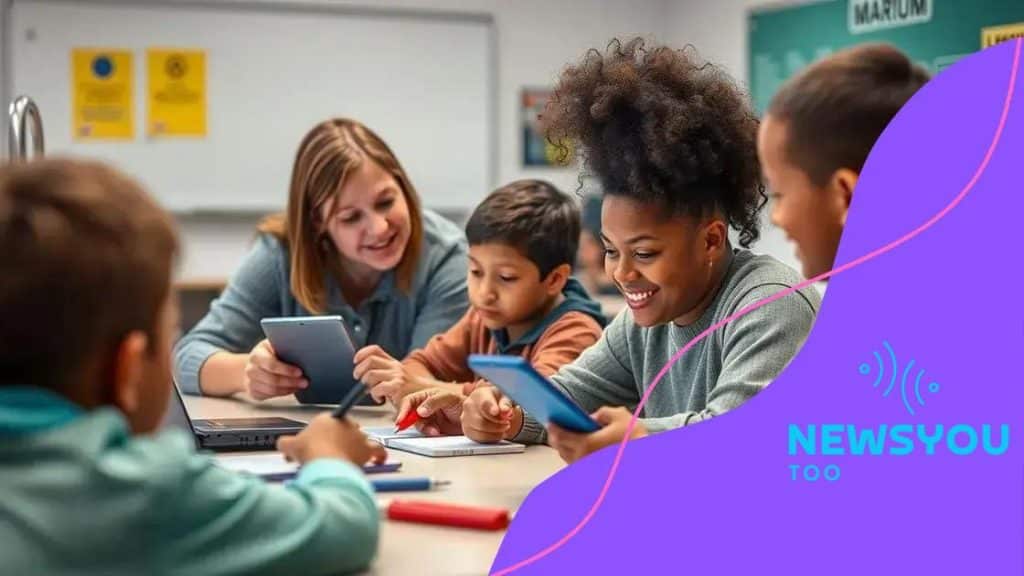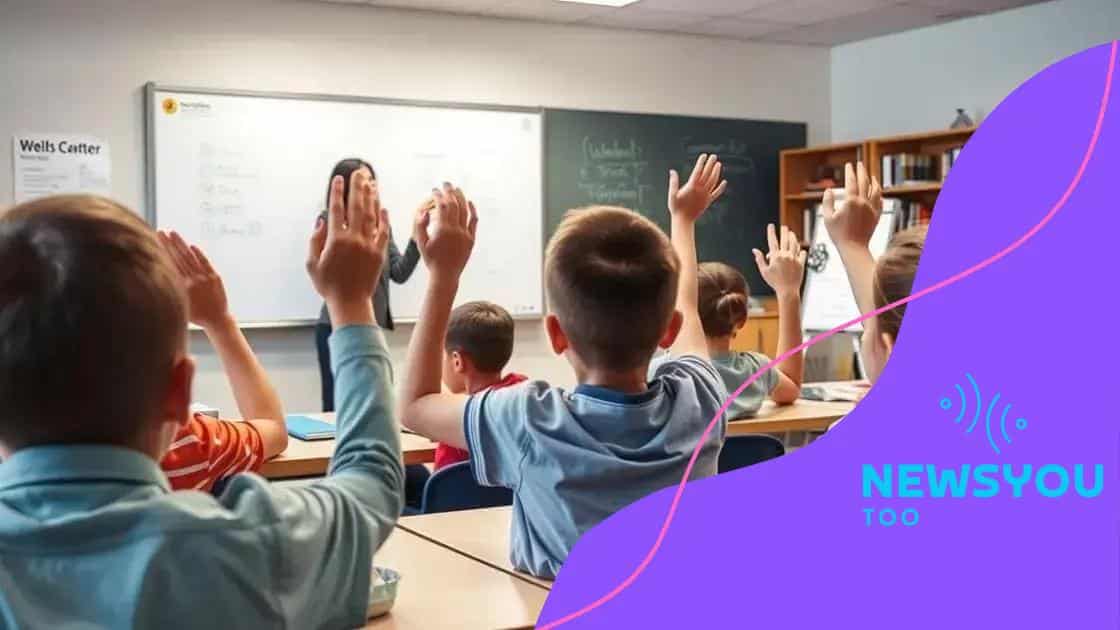How to improve teacher-student communication using technology

Anúncios
To improve teacher-student communication using technology, integrate tools like Google Classroom, use multimedia resources, and encourage feedback to enhance engagement and collaboration in the learning environment.
How to improve teacher-student communication using technology isn’t just a trend; it’s a vital strategy in today’s educational landscape. Have you ever wondered how a simple app could transform learning?
Anúncios
The role of technology in modern classrooms
Technology plays a vital role in today’s classrooms. It facilitates learning by connecting students and teachers in ways that were unimaginable just a few decades ago. Whether it’s through online platforms, communication apps, or interactive tools, the presence of technology enriches the learning environment.
Enhancing Collaboration
Incorporating technology allows for enhanced collaboration among students. Tools like Google Classroom enable group work and enable students to share resources easily. With these websites, students can learn from home and interact with peers in real-time, making education more accessible.
- Access to diverse resources
- Real-time feedback
- Encouraging teamwork
Another significant advantage of technology in classrooms is the ability to provide customized learning experiences. Adaptive learning software can adjust to each student’s pace and style. This ensures that every learner receives support tailored to their individual needs.
Anúncios
Improving Engagement
Technology also boosts student engagement. Interactive whiteboards, tablets, and educational apps capture students’ attention much more than traditional teaching methods.
Imagine a classroom where students actively participate in their lessons using educational games. This kind of engagement encourages deeper understanding and retention of material. Teachers can introduce gamification strategies to make learning fun. It helps transform a typical lesson into an enjoyable experience.
Furthermore, technology facilitates access to information. Students can gather data quickly online, which encourages research and stimulates critical thinking. When students explore various topics extensively, they develop important skills that go beyond the classroom.
Overall, the integration of technology creates a dynamic learning experience that prepares students for the challenges of the modern world. As technology continues to evolve, its role in education will likely expand, making it essential for teachers to embrace these tools.
Tools that enhance communication
In today’s educational setting, various tools play a crucial role in enhancing communication between teachers and students. These tools provide pathways for effective interaction, making learning more engaging and accessible.
Collaboration Platforms
Collaboration platforms, like Microsoft Teams and Slack, are popular among educators. They streamline communication by allowing teachers to create dedicated channels for different subjects. This helps in organizing discussions and materials effectively while ensuring that everyone stays informed.
- Email notifications for updates
- File sharing capabilities
- Streamlined group discussions
Moreover, apps like Padlet and Trello encourage teamwork on projects. Students can contribute ideas, share resources, and provide feedback, leading to a more interactive learning environment.
Communication Apps
Dedicated communication apps, such as Remind and ClassDojo, facilitate direct messaging between teachers and students or parents. These apps enable teachers to send quick announcements or reminders about assignments, enhancing overall engagement.
Beyond messaging, these tools allow for progress tracking and communication with parents, fostering a supportive educational network. This results in a cohesive approach where everyone involved stays aligned with the learning objectives.
Additionally, video conferencing tools like Zoom and Google Meet have revolutionized how teachers conduct lessons. They allow for real-time interaction, making remote learning possible. Teachers can share their screens, present lessons, and hold discussions in a more personal way.
Ultimately, using the right tools can significantly enhance communication in educational settings. By integrating these technologies, both teachers and students can benefit from clearer, more effective interactions that promote learning.
Best practices for effective teacher-student interactions

Effective teacher-student interactions are essential for a positive learning environment. By following best practices, educators can enhance communication and engagement in their classrooms.
Establish Clear Expectations
One of the first steps in fostering a productive atmosphere is to establish clear expectations. Teachers should communicate their goals for the class and what they expect from students. This clarity helps students understand how to succeed.
- Set classroom rules collaboratively.
- Outline assignment deadlines and grading criteria.
- Encourage students to ask questions.
When students know what is expected of them, they feel more confident participating actively in their learning.
Encourage Open Communication
Another vital practice is to encourage open communication. Teachers should create an environment where students feel safe to express their thoughts and opinions. Active listening is key here.
Using tools such as anonymous surveys might help gather student feedback on lessons. This can lead to meaningful discussions that empower students, making them feel valued.
Additionally, checking in with students regularly can help identify any challenges they face. Simple questions about how they are feeling in class can open the door to important conversations.
Utilize Technology Effectively
Integrating technology can also boost interactions. Teachers can use chat apps, forums, or learning management systems to enhance communication.
Tools like discussion boards allow students to engage with each other and the content outside of classroom hours. This kind of interaction encourages collaboration and builds a sense of community among students.
Furthermore, using video calls can help maintain connections, especially in remote learning situations. Face-to-face interactions, even through a screen, can help strengthen the teacher-student bond.
Incorporating these best practices can make a significant impact on the effectiveness of teacher-student interactions. With clear expectations, open communication, and the right technology, both teachers and students can thrive in the learning process.
How to integrate technology into daily lessons
Integrating technology into daily lessons can greatly enhance the learning experience. It helps engage students and makes learning more interactive.
Choose the Right Tools
First, it’s important to select the appropriate tools that fit your teaching style and subject matter. Platforms like Google Classroom and educational apps can streamline lesson planning and student collaboration.
- Experiment with different apps to find what works best.
- Look for tools that align with learning objectives.
- Incorporate both online and offline resources.
By choosing the right tools, teachers can create a more dynamic classroom environment.
Incorporate Multimedia Resources
Using multimedia resources can keep students engaged. Videos, podcasts, and interactive simulations can bring lesson topics to life.
For instance, incorporating a short educational video related to the lesson topic can stimulate discussion and provide a different perspective. It allows students to process information in various formats, catering to different learning styles.
Utilizing digital presentations also creates an interactive platform for sharing information. Students can work in groups to prepare presentations, which promotes collaboration and communication skills.
Encourage Student Participation
Engagement is key in technology integration. Tools like Kahoot! or Quizizz can make reviewing material enjoyable and fun.
These platforms allow teachers to create quizzes that students can answer in real-time. This not only reinforces learning but also fosters a spirit of healthy competition.
To further challenge students, consider assigning collaborative projects using digital platforms where they can share research and insights. This not only encourages teamwork but also develops their technological skills.
Overall, integrating technology effectively in daily lessons helps provide a more interactive and engaging educational experience for students. With the right tools and strategies, teachers can enhance learning while preparing students for a tech-driven world.
Measuring the impact of technology on communication
Measuring the impact of technology on communication in educational settings is essential for understanding its effectiveness. By assessing how technology influences interactions, teachers can adapt their strategies to better serve students.
Assessing Student Engagement
One way to measure this impact is by assessing student engagement. Tools such as surveys or feedback forms can reveal how students feel about their interactions with teachers and peers.
- Evaluate participation rates in class discussions.
- Track attendance in online sessions.
- Use engagement metrics from digital platforms.
By analyzing this data, educators can identify trends and make necessary adjustments to improve communication.
Analyzing Academic Performance
Another important aspect is analyzing academic performance. Comparing assessment results before and after integrating technology can provide insights into its impact.
For example, if test scores in a subject improve following the introduction of an interactive learning platform, it may indicate that technology enhances understanding and retention.
Additionally, monitoring students’ progress over time can help identify which tools are the most effective in promoting learning.
Feedback and Communication
Regular feedback from students is crucial in measuring the impact of technology on communication. Creating a culture where students can share their thoughts openly encourages honest dialogue.
Utilizing online polls or discussion forums can facilitate this process, allowing students to express their opinions about the technology used in the classroom. By acknowledging student input, teachers can strengthen relationships and foster a more collaborative learning environment.
Finally, observing changes in communication styles among students can also indicate the effectiveness of technology. If students become more confident in expressing their ideas and collaborating with peers, it suggests that technology positively impacts their interactions.
By focusing on these key areas, educators can effectively measure how technology influences communication, providing valuable insights to enhance teaching practices.
FAQ – Questions about Technology’s Role in Teacher-Student Communication
How can technology improve communication between teachers and students?
Technology enhances communication by providing tools for real-time interaction, feedback, and collaborative learning.
What types of tools can be used to facilitate communication?
Tools like Google Classroom, Zoom, and various messaging apps help improve collaboration and engagement.
How do I measure the impact of technology on classroom communication?
You can assess student engagement, academic performance, and feedback to evaluate how effective technology is in communication.
What are some best practices for integrating technology in lessons?
Choose the right tools, incorporate multimedia, encourage participation, and continuously seek student feedback to enhance learning.





